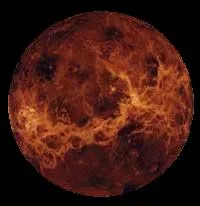
The Planet Venus
Depending on the time of year, if you go outside on a clear night after sunset or morning just before sunrise you will see what looks like a very bright star. It will appear to be brighter than any other star in the sky. That star is the planet Venus. Venus is the brightest object in the sky, other than the moon and the sun of course.
Venus can be visible in the sky for at most a few hours before sunrise or after sunset. This is because Venus is closer to the sun than the earth. Any planet you see in the sky near midnight has to be further away from the sun than the earth.
Venus has been admired for centuries as both the Morning Star and the Evening Star depending on which side of the sun it is relative to the earth.
Why is Venus so bright?
- We already mentioned that Venus is close to the sun so a lot of sunlight hits it's surface.
- Venus is one of the larger of the four small inner planets.
- The atmosphere of Venus consist of light clouds of carbon dioxide which reflects a lot of light.
Why is Venus so hot?
Even though Mercury is closer to the sun, the temperature in the sun on Venus is the hottest place of any planet in the solar system.
The atmosphere of Venus os mostly carbon dioxide which you may have heard is a greenhouse gas. This carbon dioxide atmosphere holds the heat that comes form the sun which is pretty close.
Venus spins very slowly so if you are on the sunny side you will be in the sun for about 120 days.
A day is longer than a year on Venus?
Yes, believe it or not this is true. Planets spin on their axis like a top as they travel around (orbit) the sun. The time it takes for one spin on it's axis is called a day. The time it takes to travel around (orbit) the sun is called a year. Venus is close to the sun the time it takes to orbit the sun is short compared to planets that are further away. Venus spins very slowly. So slow that it takes longer for it spin one time than it takes to orbit the sun.
In the time it takes Venus to spin once the earth spins 243 times. This means it takes 243 earth days for Venus to experience one day. So a day on Venus is 243 earth days.
In the time it takes Venus to orbit the sun the earth spins 224 times so a year on Venus is 224 Earth days.
Since 224 days is less than 243 days, a day on Venus os longer than a year on Venus!
